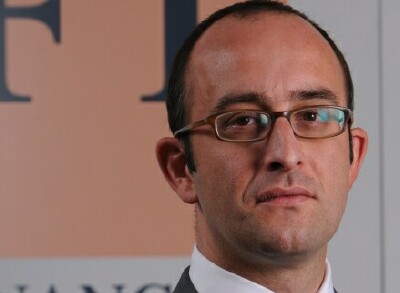Jon Slade of The Financial Times -- The Jay Sears Interview

Continuing a recent series of interviews with global trading desk heads that culminated in his Six Advertising Automation Trends for Buyers and Sellers, Jay Sears, SVP at Rubicon Project now hears from the sell side—leading publishers across the United States and Europe.
Today he speaks with the Financial Times.
Your Name: Jon Slade
Your Company: Financial Times
Your Title: Commercial Director, Global Digital Advertising & Insight
What Flavor Ice Cream Best Describes Your Management Style:
Tutti Frutti.
SEARS: On average—out of each $1.00 of advertising revenue received by your company, how much today is from automated or programmatic channels?
SLADE: £0.01. Our adoption curve is pretty advanced in our UK market – we work mainly with private marketplace and preferred deal type arrangements, plus surfacing our own data into deals. That’s partly a reflection of what we see in demand in the UK market, but the relatively low percentage is indicative that this type of business is still the minority in programmatic.
SEARS: What was this number two years ago, in 2011?
SLADE: £0.00
SEARS: What will this number be in 2015?
SLADE: £0.10 – I believe that 10% of our revenue will be generated via programmatic or automated channels within two years. In fact, that’s an internal KPI. There are a couple of reasons that we want to actively drive adoption – firstly we see an efficiency gain. And secondly we see great potential in creating genuine data-driven partnerships that augment our direct-sold premium executions – working smarter with our clients for better mutual outcomes.
SEARS: Describe how most media (all media, digital + non-digital, non-programmatic media) is sold by your company today.
SLADE: We work across both print and digital media and across 20+ countries and 24 time zones, so it’s a pretty complex set-up. Only digital is currently transacted in an automated manner and we rely on Rubicon (Project) to power that for us.
Lead times for print and digital can range from months (or a year) in advance for highly premium and date-sensitive positions, particularly in our Luxury portfolio, to 24-hours’ notice, to real-time.
We are always seeking to address how we add maximum value to our key client and agency relationships – we have access to some tremendous data, which we think can really help out in that regard – so to that end we’re active in looking to look to automate as many sales channels as possible, to allow us to concentrate on really adding value where we can.
SEARS: Tell us the about Financial Times
SLADE: The Financial Times is one of the world’s leading business news organisations, recognised internationally for its authority, integrity and accuracy. It provides essential news, comment, data and analysis for the global business community.
The Financial Times’ advertising sales operations are based on building a bridge for advertising customers to our ultra high-end, powerful and hard-to-reach global audience. We do this by making sure that our teams have valuable audience insights and analytics to share with our customers; that our creative ideas are engaging and fresh; that our audience targeting in both print and online is laser-focused; and that the operations and fulfillment elements of our business are world class.
SEARS: What are Financial Times’ three biggest initiatives for 2014?
SLADE: (For the sales operation)
1. Create value for our customers by bringing data insights closer to their business.
2. Continue to keep ahead of the curve on digital advertising and fast moving platforms such as native, social, video, mobile.
3. Talk more with our trading partners about advertising currencies that really matter – for example time spent with brand messaging, not just impressions served.
SEARS: To reach a higher adoption of direct deal automation (also known as programmatic premium) and use of the programmatic channel, what are the major impediments to overcome? Rank these in numerical order:
SLADE:
___ 1 Operational or workforce issues inside the holding companies or operating agencies
___ 5 Premium (direct deal) inventory availability via programmatic
___ 3 Lack of proper ad technology
___ 2 Alignment of agency compensation models
___ 4 Alignment of publisher compensation models
___ Other: __________________________
SLADE: The main problem we see is a lack of demand for DDA/PP (direct deal automation/programmatic premium). Too many parties in the ecosystem still perceive programmatic as a low-cost, last-click optimization/re-targeting tool, expecting to pay a rock-bottom price because it’s “just remnant.” The game needs to move on! That’s probably an attitude issue rather than a technology concern – and we are definitely seeing the start of a swing towards enlightenment.
SEARS: Tell us about your first party data strategy—do you currently have a DMP (data management platform) for your first party data?
SLADE: Yes, we are using Krux. Prior to that we used a variety of DMP-style products for the last ten years to manage our advertising audience data – some advertising-specific and others built in-house as part of the FT’s broader customer data strategy. Collecting, managing and surfacing first party data is our specialty and a very considerable part of our sales armory, and if the comments of others – suppliers, clients and competitors - are anything to go by then we’re really pretty good at it.
We are happy to surface ourfirst party data in (Rubicon Project) Connect packages – why wouldn’t we add value by doing that? We’ve said that from day one. Every impression on FT.com has up to two dozen targetable data points against it, so our task is to bring that data together and create smart packages for our customers that help them reach the perfect audience target – and of course we are very strong believers in the ethos of audience + environment = optimum opportunity.
SEARS: Salesforce compensation. Do you compensate your salespeople for every dollar or Pound sold, regardless if the media is sold via insertion order (IO) manually or via an automated channel?
SLADE: Our salespeople are compensated on every dollar sold via private marketplace, fundamentally because it still needs a sales job done if it’s going to be done properly. But I think technology providers could make this allocation of revenue easier to attribute.
SEARS: Direct sold inventory is often sold three to 12 months in advance. Which of the following choices best describe how you use direct order automation and Connect—check all that apply:
SLADE:
1. X_ We use direct order automation and Connect to leverage our first party data and bundle it with our media;
2. X We use direct order automation and Connect to make available an “electronic version” of our media kit and related editorial calendar inventory packages (example: holiday or back-to-school themed packages) to buyers;
3. X_ We use direct order automation and Connect to make available premium placements such as home page, section pages and other opportunities that are not available in the open market;
4. X_ We use direct order automation and Connect to make available IAB Rising Star ad units and rich media ad units.
5. ___ We do not use direct order automation and Connect and believe all inventory should be sold via auction (with appropriate business rules, of course!)
6. ___ Other, please describe:
SLADE: Our aspiration is to have programmatic/automated channels represent our media opportunities in as close a way to direct-sold as possible. Clearly we set smart business rules around that, but if you’re not working that way then I think you’re contributing to the mindset that programmatic is just about vanilla remnant inventory, and then you can’t complain if your floor price doesn’t move off a cent.
SEARS: What advertising opportunities will never be sold via advertising automation?
SLADE: Never is a long time… Arguably any opportunity, even the most bespoke, might ultimately be transacted via advertising automation, albeit person-person interaction still occurs during that process on idea creation, rate negotiation etc.
SEARS: Have you received “Programmatic RFPs” for your inventory? What do these look like and how are they different than traditional RFPs?
SLADE: We're certainly seeing increased levels of ‘Programmatic RFPs’ – but often as part of an integrated digital RFP, so a request to provide information across all our digital platforms and entry points.
SEARS: What should top publisher chief revenue officers (CROs) do to build their direct order automation (also known as programmatic premium) and programmatic selling business with trading desks and operating agencies?
SLADE: It’s old school, but it works: talk to the agencies. Tell them why you’re worth dealing with, what makes you special, what value you are bringing to the party, and how you’re interested to experiment in this brave new world (not so new now!). Don’t just sit on the edge of the party over-thinking it – participate and help create the rules of engagement.
SEARS: Why is direct deal automation (also known as programmatic premium) so important? Is it important?
SLADE: Workflow efficiency and the opportunity to blend brand publisher data pools into the buy and layer across inventory are the obvious reasons for us.
Tell Us a bit more about you:
SEARS: If you could travel for pleasure anywhere in the world, to a place you have never been, where would you go?
SLADE: The biggest luxury right now would be to get some sleep – I have nine week old twins – so the greatest pleasure would be to travel to my bed. I don’t feel like I have been there in a very long time.
SEARS: If you were trapped alone on a desert island and needed to choose one ad holding company CEO to accompany you, which CEO would you pick and why?
SLADE: SMS (Sir Martin Sorrell) – he could teach me how to play cricket. I’m rubbish, and as an Englishman feel very bad about that.
SEARS: When is the last time you went out for a three martini lunch?
SLADE: 2003. My name is Jon, not Don.
Thanks Jon!
Jay Sears is Senior Vice President, Marketplace Development for the Rubicon Project. Sears works with leadership and business unit heads across the company to expand Rubicon Project’s potential market. Sears has also served as General Manager, REVV Buyer, where he was responsible for global relations with the buy side including ad holding companies, ad agencies, agency trading desks and demand side platforms headquartered in North America. Jay can be reached at jsears@rubiconproject.com.
with leadership and business unit heads across the company to expand Rubicon Project’s potential market. Sears has also served as General Manager, REVV Buyer, where he was responsible for global relations with the buy side including ad holding companies, ad agencies, agency trading desks and demand side platforms headquartered in North America. Jay can be reached at jsears@rubiconproject.com.
Check us out on Facebook at MediaBizBloggers.com
Follow our Twitter updates at @MediaBizBlogger
The opinions and points of view expressed in this commentary are exclusively the views of the author and do not necessarily represent the views of MediaBizBloggers.com management or associated bloggers. MediaBizBloggers is an open thought leadership platform and readers may share their comments and opinions in response to all commentaries.


